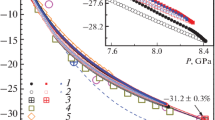Abstract
A model is proposed that makes it possible to calculate the temperature dependence of the microhardness of glass over the entire temperature range from the softening temperature to absolute zero. The calculation uses the temperature dependence of the glass enthalpy and the value of its microhardness at the glass transition temperature. The proposed model is tested on the example of glassy selenium. For this, the temperature dependence of the microhardness of selenium on the softening temperature up to 100 K, which is 50 K below its Debye temperature, is measured. Thus, a relationship is established between the strength and thermodynamic properties of glass.

Similar content being viewed by others
REFERENCES
Tveryanovich, Yu.S., On the correlation of the microhardness and softening temperature for chalcogenide glasses, Glass Phys. Chem., 2022, vol. 48, no. 1, pp. 72–74.
Tveryanovich, Yu.S., The relationship between microhardness and glass transition temperature of chalcogenide glasses, Glass Phys. Chem., 2022, vol. 48, no. 4, pp. 243–247.
Andrievskii, R.A., Lanin, A.G., and Rymashevskii, G.A., Prochnost’ tugoplavkikh soedinenii (Strength of Refractory Compounds), Moscow: Metallurgiya, 1974.
Kasap, S.O., Yannacopoulos, S., and Gundappa, P., Mechanical properties of the semiconducting glass A-Se in the T g region via thermomicrohardness and measurements, J. Non-Cryst. Solids, 1989, vol. 111, pp. 82–90.
Yannacopoulos, S. and Kasap, S.O., Scientific instrumentation for hot microhardness measurements on amorphous solids, Rev. Sci. Instrum., 1989, vol. 60, p. 1321.
Ho, C.Y., Powell, R.W., and Liley, P.E., Thermal conductivity of the elements: A comprehensive and review, J. Phys. Chem. Ref. Data, 1974, vol. 3, no. 1 (suppl.), pp. 1–796.
Wang, S., Xu, H., Wang, Y., Kong, L., Wang, Z., Liu, S., Zhang, J., and Zhao, H., Design and testing of a cryogenic indentation apparatus, Rev. Sci. Instrum., 2019, vol. 90, p. 015117.
Gaur, U., Shu, H., Mehta, A., and Wunderlich, B., Heat capacity and other thermodynamic properties of linear macromolecules. I. Selenium, J. Phys. Chem. Ref. Data, 1981, vol. 10, no. 1, pp. 89–118.
Etienne, S., Guenin, G., and Perez, J., Ultrasonic studies of the elastic coefficients of vitreous selenium about T g, J. Phys. D: Appl. Phys., 1979, vol. 12, no. 12, pp. 2189–2202.
Kozhevnikov, V.F., Payne, W.B., Olson, J.K., Allen, A., and Taylor, P.C., Sound velocity in liquid and glassy and selenium, J. Non-Cryst. Solids, 2007, vol. 353, pp. 3254–3259.
Borisova, Z., in Glassy Semiconductors, Boston, MA: Springer, 1981, pp. 37–168.
Funding
This study was supported by the Russian Foundation for Basic Research, grant no. 20-03-00185, on the 300th anniversary of the founding of St. Petersburg State University.
Author information
Authors and Affiliations
Corresponding author
Ethics declarations
The authors declare that they have no conflicts of interest.
Rights and permissions
About this article
Cite this article
Wang, S., Tver’yanovich, Y.S. Relationship of Temperature Dependences of Microhardness and Enthalpy of Glass on the Example of Selenium. Glass Phys Chem 49, 336–339 (2023). https://doi.org/10.1134/S1087659623600266
Received:
Revised:
Accepted:
Published:
Issue Date:
DOI: https://doi.org/10.1134/S1087659623600266




